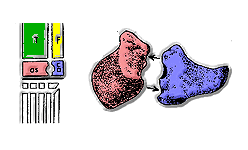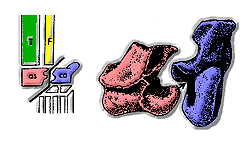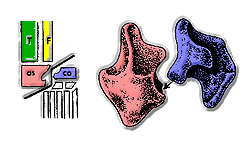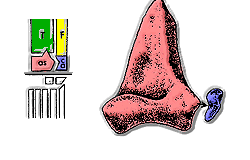Archosaur
| Archosaurs | |||
|---|---|---|---|
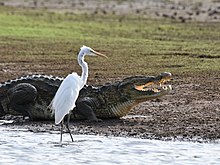
| |||
| Birds and crocodilians (in this case, a great egret and a mugger crocodile) are the only living archosaur groups. | |||
| Scientific classification | |||
| Domain: | Eukaryota | ||
| Kingdom: | Animalia | ||
| Phylum: | Chordata | ||
| Class: | Reptilia | ||
| Clade: | Archosauromorpha | ||
| Clade: | Archosauriformes | ||
| Clade: | Eucrocopoda
| ||
| Clade: | Archosauria Cope, 1869 | ||
| Subgroups | |||
| |||
| Synonyms | |||
| |||
Archosauria (lit. 'ruling reptiles') is a
Older definitions of the group Archosauria rely on shared
Distinguishing characteristics
Archosaurs can traditionally be distinguished from other tetrapods on the basis of several
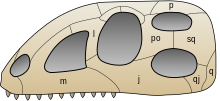
The most obvious features include teeth set in deep sockets,
Unlike their close living relatives, the lepidosaurs, archosaurs lost the vomeronasal organ.[10]
Origins
Archosaurs are a subgroup of archosauriforms, which themselves are a subgroup of archosauromorphs. Both the oldest archosauromorph (Protorosaurus speneri) and the oldest archosauriform (Archosaurus rossicus) lived in the late Permian. The oldest true archosaurs appeared during the Olenekian stage (247-251 Ma) of the Early Triassic. A few fragmentary fossils of large carnivorous crocodilian-line archosaurs (informally termed "rauisuchians") are known from this stage. These include Scythosuchus and Tsylmosuchus (both of which have been found in Russia),[11] as well as the Xilousuchus, a ctenosauriscid from China.[4] The oldest known fossils of bird-line archosaurs are from the Anisian stage (247-242 Ma) of Tanzania, and include Asilisaurus (an early silesaurid), Teleocrater (an aphanosaur), and Nyasasaurus (a possible early dinosaur).[citation needed]
Archosaurian domination in the Triassic
- Archosaurs made more rapid progress towards erect limbs than synapsids, and this gave them greater stamina by avoiding Carrier's constraint. An objection to this explanation is that archosaurs became dominant while they still had sprawling or semi-erect limbs, similar to those of Lystrosaurus and other synapsids.[citation needed]
- Archosaurs have more efficient[clarification needed] respiratory systems featuring unidirectional air flow.[14] The ability to breathe more efficiently in hypoxic conditions may have been advantageous to early archosaurs during the suspected drop in oxygen levels at the end of the Permian.[14]
- The Early Triassic was predominantly arid, because most of the Earth's land was concentrated in the supercontinent Pangaea. Archosaurs were probably better at conserving water than early synapsids because:
- Modern diapsids (lizards, snakes, crocodilians, birds) excrete uric acid, which can be excreted as a paste, resulting in low water loss as opposed to a more dilute urine. It is reasonable to suppose that archosaurs (the ancestors of crocodilians, dinosaurs and pterosaurs) also excreted uric acid, and therefore were good at conserving water. The aglandular (glandless) skins of diapsids would also have helped to conserve water.[citation needed]
- Modern mammals excrete
However, this theory has been questioned, since it implies synapsids were necessarily less advantaged in water retention, that synapsid decline coincides with climate changes or archosaur diversity (neither of which tested) and the fact that desert dwelling mammals are as well adapted in this department as archosaurs,[15] and some cynodonts like Trucidocynodon were large sized predators.[16] A study favors competition amidst mammaliaforms as the main explanation for Mesozoic mammals being small.[17]
Main forms
Since the 1970s, scientists have classified archosaurs mainly on the basis of their ankles.
The
Euparkeria and the Ornithosuchidae had "reversed crurotarsal" ankles, with a peg on the calcaneum and socket on the astragalus.
The earliest fossils of Avemetatarsalia ("bird ankles") appear in the Anisian age of the Middle Triassic. Most Ornithodirans had "advanced mesotarsal" ankles. This form of ankle incorporated a very large astragalus and very small calcaneum, and could only move in one plane, like a simple hinge. This arrangement, which was only suitable for animals with erect limbs, provided more stability when the animals were running. The earliest avemetatarsalians, such as Teleocrater and Asilisaurus, retained "primitive mesotarsal" ankles. The ornithodirans differed from other archosaurs in other ways: they were lightly built and usually small, their necks were long and had an S-shaped curve, their skulls were much more lightly built, and many ornithodirans were completely bipedal. The archosaurian fourth trochanter on the femur may have made it easier for ornithodirans to become bipeds, because it provided more leverage for the thigh muscles. In the late Triassic, the ornithodirans diversified to produce dinosaurs and pterosaurs.
Classification
Modern classification
Archosauria is normally defined as a
History of classification
Archosauria as a term was first coined by American paleontologist
Cope's term was a Greek-Latin hybrid intended to refer to the cranial arches, but has later also been understood as "leading reptiles" or "ruling reptiles" by association with Greek ἀρχός "leader, ruler".[25]
The term "thecodont", now considered an obsolete term, was first used by the English paleontologist
With the identification of "crocodilian normal" and "crocodilian reversed" ankles by Sankar Chatterjee in 1978, a basal split in Archosauria was identified. Chatterjee considered these two groups to be Pseudosuchia with the "normal" ankle and Ornithosuchidae with the "reversed" ankle. Ornithosuchids were thought to be ancestral to dinosaurs at this time. In 1979, A.R.I. Cruickshank identified the basal split and thought that the crurotarsan ankle developed independently in these two groups, but in opposite ways. Cruickshank also thought that the development of these ankle types progressed in each group to allow advanced members to have semi-erect (in the case of crocodilians) or erect (in the case of dinosaurs) gaits.[26]
Phylogeny
In many
| Sauropsida |
| ||||||||||||||||||||||||||||||||||||||||||||||||
In 1988, paleontologists
The clades Crurotarsi and Ornithodira were first used together in 1990 by paleontologist Paul Sereno and A.B. Arcucci in their phylogenetic study of archosaurs. They were the first to erect the clade Crurotarsi, while Ornithodira was named by Gauthier in 1986. Crurotarsi and Ornithodira replaced Pseudosuchia and Ornithosuchia, respectively, as the monophyly of both of these clades were questioned.[26][29] Sereno and Arcucci incorporated archosaur features other than ankle types in their analyses, which resulted in a different tree than previous analyses. Below is a cladogram based on Sereno (1991), which is similar to the one produced by Sereno and Arcucci:[26]
| Archosauriformes |
| ||||||||||||||||||||||||||||||||||||||||||||||||
Ornithodira and Crurotarsi are both
Benton proposed the name Avemetatarsalia in 1999 to include all bird-line archosaurs (under his definition, all archosaurs more closely related to dinosaurs than to crocodilians). His analysis of the small Triassic archosaur Scleromochlus placed it within bird-line archosaurs but outside Ornithodira, meaning that Ornithodira was no longer equivalent to bird-line archosaurs. Below is a cladogram modified from Benton (2004) showing this phylogeny:[24]
| Archosauria |
| ||||||||||||||||||||||||||||||||||||||||||||||||||||||||||||||||||||||||||||||||||||
In Sterling Nesbitt's 2011 monograph on early archosaurs, a phylogenetic analysis found strong support for phytosaurs falling outside Archosauria. Many subsequent studies supported this phylogeny. Because Crurotarsi is defined by the inclusion of phytosaurs, the placement of phytosaurs outside Archosauria means that Crurotarsi must include all of Archosauria. Nesbitt reinstated Pseudosuchia as a clade name for crocodile-line archosaurs, using it as a stem-based taxon. Below is a cladogram modified from Nesbitt (2011):[4]
| Sauropsida |
| ||||||||||||||||||||||||||||||||||||
Extinction and survival
Crocodylomorphs, pterosaurs and dinosaurs survived the Triassic–Jurassic extinction event about 200 million years ago, but other archosaurs had become extinct at or prior to the Triassic-Jurassic boundary.
Non-avian dinosaurs and
Crocodilians (which include all modern crocodiles, alligators, and gharials) and birds flourish today in the Holocene. It is generally agreed that birds have the most species of all terrestrial vertebrates.[citation needed]
Archosaur lifestyle
Hip joints and locomotion

Like the early tetrapods, early archosaurs had a sprawling gait because their hip sockets faced sideways, and the knobs at the tops of their femurs were in line with the femur. In the early to middle Triassic, some archosaur groups developed hip joints that allowed (or required) a more erect gait. This gave them greater stamina, because it avoided Carrier's constraint, i.e. they could run and breathe easily at the same time. There were two main types of joint which allowed erect legs:
- The hip sockets faced sideways, but the knobs on the femurs were at right angles to the rest of the femur, which therefore pointed downwards. Dinosaurs evolved from archosaurs with this hip arrangement.
- The hip sockets faced downwards and the knobs on the femurs were in line with the femur. This "pillar-erect" arrangement appears to have evolved independently in various archosaur lineages, for example it was common in "Rauisuchia" (non-crocodylomorph paracrocodylomorphs) and also appeared in some aetosaurs.
It has been pointed out that an upright stance requires more energy, so it may indicate a higher metabolism and a higher body temperature.[30]
Diet
Most were large predators, but members of various lines diversified into other niches. Aetosaurs were herbivores and some developed extensive armor. A few crocodyliforms were herbivores, e.g., Simosuchus, Phyllodontosuchus. The large crocodyliform Stomatosuchus may have been a filter feeder. Sauropodomorphs and ornithischian dinosaurs were herbivores with diverse adaptations for feeding biomechanics.
Land, water and air
Archosaurs are mainly portrayed as land animals, but:
- Many phytosaurs and crocodyliforms dominated the rivers and swamps and even invaded the seas (e.g., the teleosaurs, Metriorhynchidae and Dyrosauridae). The Metriorhynchidae were rather dolphin-like, with paddle-like forelimbs, a tail fluke and smooth, unarmoured skins.
- Two clades of ornithodirans, the pterosaursand the birds, dominated the air after becoming adapted to a volant lifestyle.
- Some dinosaurs like penguinsalso adapted to this lifestyle.
Metabolism
The metabolism of archosaurs is still a controversial topic. They certainly evolved from cold-blooded ancestors, and the surviving non-dinosaurian archosaurs, crocodilians, are cold-blooded. But crocodilians have some features which are normally associated with a warm-blooded metabolism because they improve the animal's oxygen supply:
- 4-chambered hearts. Both birds and mammals have 4-chambered hearts, which completely separate the flows of oxygenated and de-oxygenated blood. Non-crocodilian reptiles have 3-chambered hearts, which are less efficient because they let the two flows mix and thus send some de-oxygenated blood out to the body instead of to the lungs. Modern crocodilians' hearts are 4-chambered, but are smaller relative to body size and run at lower pressure than those of modern birds and mammals. They also have a pulmonary bypass, which makes them functionally 3-chambered when under water, conserving oxygen.
- a secondary palate, which allows the animal to eat and breathe at the same time.
- a
Historically there has been uncertainty as to why


Paleontological evidence[clarification needed] shows that the ancestors of living crocodilians were active and endothermic (warm-blooded). Some experts[who?] believe that their archosaur ancestors were warm-blooded as well. This is likely because feather-like filaments evolved to cover the whole body and were capable of providing thermal insulation.[33] Physiological, anatomical, and developmental features of the crocodilian heart support the paleontological evidence and show that the lineage reverted to ectothermy when it invaded the aquatic, ambush predator niche. Crocodilian embryos develop fully 4-chambered hearts at an early stage. Modifications to the growing heart form a pulmonary bypass shunt that includes the left aortic arch, which originates from the right ventricle, the foramen of Panizza between the left and right aortic arches, and the cog‐tooth valve at the base of the pulmonary artery. The shunt is used during diving to make the heart function as 3-chambered heart, providing the crocodilian with the neurally controlled shunting used by ectotherms. The researchers concluded that the ancestors of living crocodilians had fully 4-chambered hearts, and were therefore warm-blooded, before they reverted to a cold-blooded or ectothermic metabolism. The authors also provide other evidence for endothermy in stem archosaurs.[34][35] It is reasonable to suggest that later crocodilians developed the pulmonary bypass shunt as they became cold-blooded, aquatic, and less active.
If the crocodilian ancestors and other Triassic archosaurs were warm-blooded, this would help to resolve some evolutionary puzzles:
- The earliest crocodylomorphs, e.g., Terrestrisuchus, were slim, leggy terrestrial predators whose build suggests a fairly active lifestyle, which requires a fairly fast metabolism. And some other crurotarsan archosaurs appear to have had erect limbs, while those of rauisuchians are very poorly adapted for any other posture. Erect limbs are advantageous for active animals because they avoid Carrier's constraint, but disadvantageous for more sluggish animals because they increase the energy costs of standing up and lying down.
- If early archosaurs were completely cold-blooded and (as seems most likely) dinosaurs were at least fairly warm-blooded, dinosaurs would have had to evolve warm-blooded metabolisms in less than half the time it took for synapsids to do the same.
Respiratory system
A recent study of the lungs of Alligator mississippiensis (the
Reproduction
Most (if not all) archosaurs are
Archosaurs are ancestrally
See also
References
- PMID 22022431.
- PMID 27628503.
- ^ "Archosaur Definition & Meaning". Dictionary.com. Retrieved 2022-03-01.
- ^ S2CID 83493714.
- PMID 24586565.
- ISBN 978-0-470-65666-2.
- ^ ISBN 978-81-7141-907-4.
- ^ a b White, T.; Kazlev, M. A. "Archosauromorpha: Overview". Palaeos.com. Archived from the original on December 20, 2010. Retrieved 6 September 2012.
- ISBN 978-0-691-16766-4.
- ^ Poncelet, G., and Shimeld, S. M. (2020). The evolutionary origin of the vertebrate olfactory system. Open Biol. 10:200330. doi: 10.1098/rsob.200330
- ^ Gower, D. J.; Sennikov, A. G. (2003). "Early archosaurs from Russia". In Benton, M.J.; Shishkin, M.A.; Unwin, D.M. (eds.). The Age of Dinosaurs in Russia and Mongolia. Cambridge: Cambridge University Press. pp. 140–159.
- PMID 34739492.
- ^ "Iguana-sized dinosaur cousin discovered in Antarctica - ScienceDaily".
- ^ PMID 31928195.
- ^ Darren Naish, Episode 38: A Not Too Shabby Podcarts Archived 2016-01-27 at the Wayback Machine
- .
- S2CID 234782605.
- ^ Archosauromorpha: Archosauria - Palaeos Archived 2005-04-05 at the Wayback Machine
- PMID 31848420.
- S2CID 86610229.
- ^ Benton, M.J. (2005). Vertebrate Paleontology, 3rd ed. Blackwell Science Ltd
- doi:10.1139/e05-005.
- JSTOR 1005355.
- ^ ISBN 978-0-520-24209-8.
- ^ Pamphlets on Biology: Kofoid collection, vol. 2900 (1878), p. 731
- ^ JSTOR 3889336.
- ^ Gauthier, J.A. (1986). "Saurischian monophyly and the origin of birds". In Padian, K. (ed.). The Origin of Birds and the Evolution of Flight. Memoirs of the California Academy of Sciences. Vol. 8. San Francisco: California Academy of Sciences. pp. 1–55.
- ISBN 978-0-19-857712-6.
- S2CID 256805773.
- ^ Desmond, Adrián J., The hot-blooded dinosaurs: a revolution in palaeontology. 1976, Dial Press, page 87.
- S2CID 84693210.
- .
- S2CID 24319963.
- S2CID 10111065.
- S2CID 4399224.
- ^ S2CID 206522844.
- ^ Lisa Grossman (January 14, 2010). "Alligators breathe like birds". Science News. Archived from the original on September 29, 2012. Retrieved January 14, 2010.
- .
- S2CID 4416203.
- .
- ISSN 1755-6910.
- PMID 28195584.
- ISBN 978-0-691-15061-1
- S2CID 131332250.
- PMID 26605799.
Sources
- Benton, M. J.(2004). Vertebrate Paleontology (3rd ed.). Blackwell Science.
- ISBN 978-0-7167-1822-2.
External links
- UCMP
- Paleos reviews the messy history of archosaur phylogeny (family tree) and has an excellent image of the various archosaur ankle types.
- Mikko's Phylogeny Archive Archosauria

